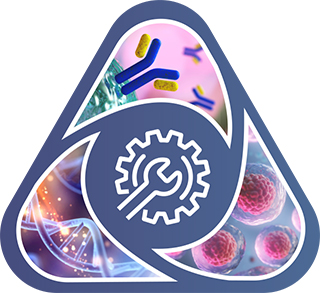
Much of the work carried out by DTT is in support of the National Toxicology Program (NTP), an interagency partnership of the Food and Drug Administration, National Institute for Occupational Safety and Health, and NIEHS.

Public Health Significance
The field of toxicology is moving toward more efficient and reduced use of animals, with a greater reliance on in vitro models as well as analytical methods and innovative technologies that rapidly provide human-relevant data to better inform public health decision-making. The NIEHS Division of Translational Toxicology (DTT) has historically sought innovative methods for addressing toxicological problems in hazard and risk assessment. There is a critical need for a portfolio of fit-for-purpose tools and approaches that can be easily and rapidly deployed to provide information on potential human hazards and risks from exposure.
Research Objectives
The three main objectives of Novel Tools and Approaches (NTA) research are to:
- Identify and adapt promising new tools, technologies, and approaches that could enhance the efficiency and translational relevance of DTT hazard assessments.
- Ensure that novel capability development is aligned with contemporary problems that DTT is attempting to solve.
- Increase confidence in — and adoption of — novel methods within and outside DTT, and foster the development of novel, non-standard methods where none currently exist, focusing on high-interest in vitro systems and short-term in vivo assays.
The NTA will focus on three research areas to advance these objectives. These three broad areas, along with examples of each, are:
- Spheroids and Organoids
- HepaRG 3D liver cell, metabolically competent spheroids
- Neural stem cell spheroids for developmental neurotoxicology
- Embryoid bodies driven to specific cell types to form organoids
- Microphysiological Systems
- Organs-on-a-chip
- Microfluidic chip
- Novel Technologies with high dimensional data streams
- Innovative imaging systems and analysis
- Tox21 high-throughput screening program and cross-partner projects
- High-throughput transcriptomics (e.g., S1500+ platform)
- Air-liquid interface exposure system
Ultimately, the NTA will identify, evaluate, and implement new research tools and approaches that advance translatable, predictive, and timely toxicology in areas critical to the DTT mission and to DTT stakeholders.
Background
DTT has a long history of using innovative tools to better solve toxicology problems in hazard and risk assessment. For example, DTT has been involved in the Tox21 Program, which began as an interagency collaboration to predict (with improved accuracy) the toxicological effects of substances within large chemical libraries more rapidly than standard approaches by integrating computational biology and robotic high-throughput screening for biological activity.
Initial efforts of the Tox21 Program resulted in the development of a chemical library of about 10,000 compounds covering a sizeable range of chemical space. The chemical library was screened for activity in nuclear receptor and cellular stress response signaling pathways. By the beginning of 2021, just under one million data points generated through Tox21 Program activities have been deposited into PubChem, and the program has generated more than 200 publications in more than 50 journals to date.
Now, the Tox21 Program is in its third phase, investigating in greater detail toxicologic features such as metabolic competence and genome-wide transcriptional responses that are relevant to chemical exposures of environmental and pharmaceutical interest.
The S1500+ high-throughput transcriptomic platform is another example of the successful development by DTT of a new technology platform that has now gained widespread acceptance and use. This platform helps to measure chemical exposure-induced gene expression changes in more than 3,000 genes, covering 96% of all known human cell signaling pathways.
At the time of its establishment, the NTA was assigned a broad portfolio of research and development projects and capabilities that represent increasing complexity, spanning from in vitro methods to short-term in vivo tests. Going forward, in addition to managing current projects in that portfolio, the NTA will perform regular reviews of the entire landscape of emerging technologies and applications to identify new bioassays or biological systems as well as novel technologies and unconventional approaches that could be useful to ongoing DTT research projects and the wider toxicology community.
Select Studies
| Study | Description | Findings/Supporting Files |
|---|---|---|
| 5-day in Vivo Rat Studies | To examine 10 aromatic phosphate and per- and polyfluoroalkyl substances in short-term, in vivo studies with multiple endpoints to define their transcriptomic signatures. The goal is to determine whether these short-term studies can yield data useful for public health decision-making. | Complete
|
| In Vitro to in Vivo Extrapolation (IVIVE) | Projects to evaluate hepatic clearance of PFAS (per- and polyfluoroalkyl substances) and estimate internal dose to compare with results from studies in cells. | Ongoing |
| Retrofitting Existing Tox21 High-throughput Screening (HTS) Assays With Metabolic Capability | To screen the Tox21 10K library in the p53RE assay in the presence of human or rat liver microsomes to evaluate this method for providing xenobiotic metabolism capability to Tox21 HTS assays. | Ongoing
|
| Toxicity Studies in the HepaRG 2D and 3D Models | To investigate liver toxicity, metabolism, and genotoxicity of substances in HepaRG cells using both 2D and 3D model systems. | Optimization and validation of the 3D spheroid model systems is ongoing. |
| Pluripotent Stem Cell-Based Models | To develop several 2D/3D model systems to be used for directed differentiation to specific cell types and development of multiple organoid models. These model systems will be used for screening and mechanistic investigations into the effects of chemicals on embryonic and early-life development. | Ongoing
|


